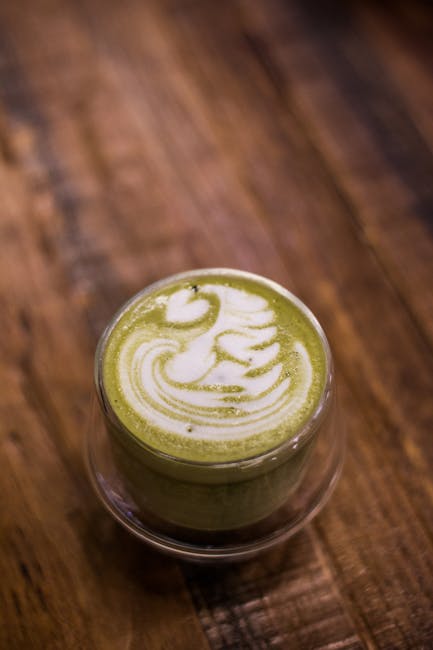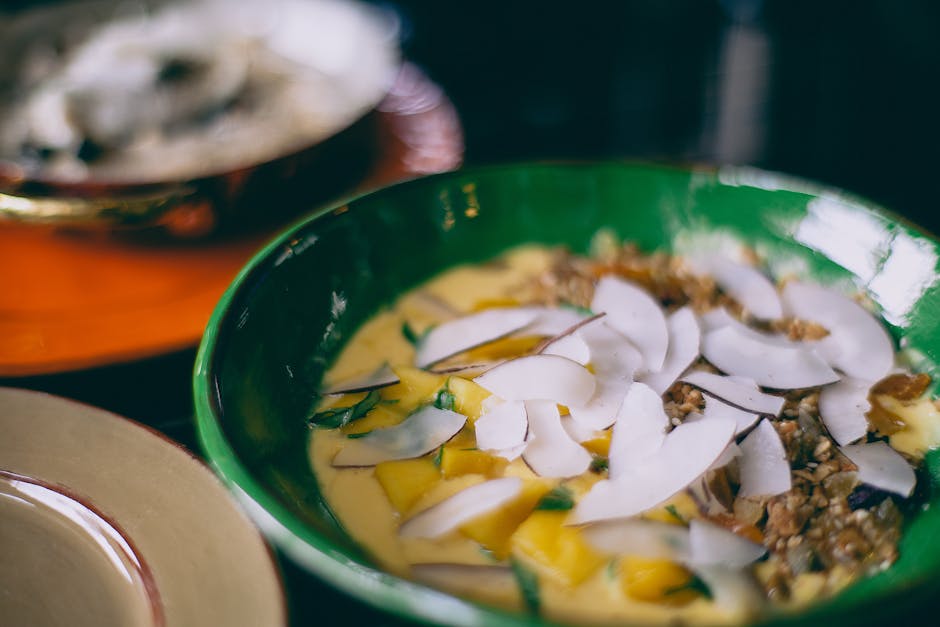Prepare yourself for a journey of taste and tradition with our Homemade Matcha Latte. This vibrant green beverage, far from being a mere trendy drink, boasts a rich history deeply interwoven with Japanese culture. Matcha, the finely ground powder of specially grown and processed green tea leaves, has been a cornerstone of Japanese society for centuries, its origins tracing back to the 12th century during the Kamakura period. Initially cultivated by Buddhist monks for its meditative properties and sustained energy, matcha quickly transcended its religious beginnings to become a beloved drink enjoyed by the aristocracy and eventually, the wider population.
The unique preparation of matcha sets it apart from other teas. Unlike traditional tea brewing where leaves are steeped and discarded, matcha involves consuming the entire leaf, resulting in a potent concentration of antioxidants, vitamins, and minerals. This explains its reputation as a health elixir, with studies suggesting potential benefits ranging from improved metabolism and focus to increased energy levels and a boosted immune system. In fact, a single cup of matcha can contain up to 137mg of caffeine, significantly less than a comparable serving of coffee, but with a more sustained release of energy, avoiding the jitters associated with coffee’s quick high and subsequent crash. This slow-release energy is one of the reasons matcha remains a popular choice among those seeking a natural and healthy energy boost.
The cultural significance of matcha extends far beyond its health benefits. In Japan, the traditional matcha whisking ceremony, known as chado or the Way of Tea, is a highly refined art form. This ritualistic preparation, involving specific tools and movements, emphasizes mindfulness, tranquility, and respect for the tea and the process. Beyond the ceremony, matcha is integral to various Japanese sweets and desserts, from elegant cakes to delicate ice cream, underscoring its versatility and its deep integration into the nation’s culinary landscape. The global popularity of matcha has exploded in recent years, with a market value estimated at over $1 billion in 2023, showcasing its widespread appeal and enduring charm.
Our Homemade Matcha Latte recipe aims to capture the essence of this timeless beverage, making it accessible and enjoyable for everyone. We’ll guide you through the process of creating a perfect balance of creamy milk, subtly sweet notes, and the unmistakable earthy, slightly bitter taste of high-quality matcha. Get ready to experience the rich history and nuanced flavors of this remarkable drink, a true testament to the enduring legacy of Japanese tea culture.
Ingredients and Measurements
Creating the perfect homemade matcha latte hinges on using high-quality ingredients and precise measurements. The following recipe yields one delicious serving, easily scalable for multiple people. Remember, consistency is key to achieving a balanced and flavorful drink.
Matcha Powder (1-2 teaspoons): This is the star of the show! The amount you use will depend on your personal preference for intensity. One teaspoon provides a subtly sweet and slightly grassy flavor, while two teaspoons offer a bolder, more pronounced matcha taste. We strongly recommend using culinary-grade matcha powder, specifically designed for beverages. Ceremonial grade matcha, while exquisite for whisking alone, can be a bit pricey for daily lattes. Look for vibrant green powder with a fine texture; clumpy or dull-colored matcha may indicate lower quality.
Hot Water (2-4 ounces): The quantity of hot water used is crucial for achieving the right consistency. Too little water and your matcha will be gritty; too much and it will be thin and watery. Start with 2 ounces of water at around 175-180°F (80-82°C). This temperature is ideal for extracting the matcha’s flavor without making it bitter. Avoid boiling water, as it can scorch the matcha and result in a harsh, unpleasant taste. If you prefer a thinner latte, gradually add more hot water until you reach your desired consistency.
Milk (8-12 ounces): Your choice of milk significantly impacts the overall flavor and texture of your matcha latte. Whole milk creates a creamy, rich latte, while skim milk provides a lighter option. Alternatives like almond milk, soy milk, oat milk, or coconut milk also work well, each offering a unique flavor profile. Experiment to find your favorite milk type. The quantity of milk depends on your preference for strength and volume. Start with 8 ounces and add more if you prefer a less concentrated latte.
Sweetener (Optional): Many find matcha naturally slightly bitter, so adding a sweetener is common practice. The amount is entirely up to your taste. Popular options include honey, maple syrup, agave nectar, or simple syrup. Begin with a small amount (1/2 teaspoon to 1 teaspoon) and add more as needed. Taste your latte before adding more sweetener to avoid making it overly sweet.
Ice (Optional): For an iced matcha latte, prepare the matcha mixture as directed above but use cold milk instead of hot milk. Add ice to your liking. Ensure your milk is thoroughly chilled for the best results in an iced latte.
Other additions (Optional): Once you’ve mastered the basic recipe, feel free to experiment with additions like vanilla extract, cinnamon, or a pinch of sea salt to enhance the flavor profile. A dash of vanilla extract can complement the matcha beautifully.
Equipment List
Making a perfect homemade matcha latte requires the right tools. While you can improvise with some items, having the proper equipment will significantly enhance your experience and the quality of your drink. This list details the essential and recommended tools, with explanations to guide your choices.
1. Matcha Whisk (Chasen): This is arguably the most crucial piece of equipment. A traditional bamboo chasen is preferred for its ability to create a smooth, lump-free matcha without excessive frothing. Look for a chasen with approximately 80-100 tines. A higher tine count generally leads to a finer whisk. Avoid using a metal whisk, as it can damage the delicate matcha powder and affect its flavor.
2. Matcha Bowl (Chawan): A wide, shallow bowl is ideal for whisking matcha. This shape allows for efficient whisking and prevents the matcha from clumping. Traditional chawan bowls are often made of ceramic or stoneware, but a simple, wide bowl will suffice. The bowl should be large enough to accommodate the matcha powder and hot water without overflowing. A diameter of approximately 4-5 inches is generally recommended.
3. Sifter (Fine-Mesh): Sifting your matcha powder before whisking is highly recommended. This removes any clumps and ensures a smooth, consistent texture in your latte. A fine-mesh sieve is perfect for this task. Using a sifter prevents gritty particles from ending up in your drink. You can purchase a dedicated matcha sifter, or a standard fine-mesh sieve from your kitchen will work just as well.
4. Measuring Spoons and Cups: Accurate measurements are key to achieving the perfect matcha latte ratio. A set of measuring spoons (ideally including a 1/2 teaspoon and 1 teaspoon measure) and a measuring cup (at least 8 ounces) will help ensure consistency in your brewing. Precise measurements contribute to a balanced flavor and texture.
5. Milk Frother (Optional but Recommended): While not strictly necessary, a milk frother significantly elevates the latte experience. A handheld milk frother is ideal for creating a creamy, textured milk that complements the matcha perfectly. Choose a frother that produces a fine, consistent foam. Alternatively, you can use a French press or even vigorously shake the milk in a jar to create some foam, but the results might not be as smooth.
6. Kettle or Pot for Hot Water: You’ll need a kettle or pot to heat your water to the correct temperature (around 175°F or 80°C). An electric kettle is convenient and allows for precise temperature control. Avoid boiling the water, as this can scorch the matcha and impart a bitter taste.
7. Small Spatula or Spoon: A small spatula or spoon is helpful for scooping matcha powder into the sifter and for cleaning your whisk afterward. A silicone spatula is a good choice as it’s gentle on the chasen.
8. Mug or Glass: Finally, you’ll need a mug or glass to enjoy your delicious homemade matcha latte! Choose a vessel that you find aesthetically pleasing and comfortable to hold.
Instructions (Preparation and Brewing)
Creating the perfect homemade matcha latte involves careful attention to detail at each stage. This recipe assumes you’re using culinary grade matcha powder, which is specifically designed for drinking and has a less intense, more palatable flavor than ceremonial grade matcha. If using ceremonial grade, reduce the amount of matcha powder slightly to avoid bitterness.
Step 1: Prepare the Matcha Paste (Usucha Method): This method produces a thinner, less intense latte. Begin by sifting 1-2 teaspoons of matcha powder into a small bowl. Sifting removes any clumps and ensures a smooth, lump-free latte. The amount of matcha you use depends on your preferred strength; start with 1 teaspoon for a milder latte and increase to 2 teaspoons for a more robust flavor. Note: Using a fine-mesh sieve is highly recommended for this step.
Step 2: Whisking the Matcha Paste: Add 2-3 tablespoons of hot water (around 175°F or 80°C), ensuring the water isn’t boiling. Boiling water can scorch the matcha and create a bitter taste. Utilize a matcha whisk (chasen) to vigorously whisk the mixture in a zig-zag motion, starting from the center and moving outwards. This process aerates the matcha, creating a frothy, smooth paste. If you don’t have a chasen, a small whisk or even a fork can be used, although the resulting texture might be slightly less smooth. Continue whisking until the paste is completely smooth and free of lumps. This should take approximately 30-60 seconds.
Step 3: Warming the Milk: While whisking the matcha paste, warm your milk of choice. You can use any type of milk – cow’s milk, almond milk, soy milk, oat milk, etc. – depending on your preference. Heat the milk gently in a saucepan on the stovetop or in a microwave until it’s warm but not boiling. Avoid overheating the milk, as this can lead to a burnt or unpleasant taste. A temperature of around 140-160°F (60-70°C) is ideal.
Step 4: Combining Matcha and Milk: Once the milk is warmed, add the prepared matcha paste to a mug or glass. Slowly pour the warm milk into the mug, while gently stirring to combine the matcha and milk. Avoid creating excessive foam at this stage unless you specifically desire a foamy latte. If you prefer a frothier latte, use a milk frother to create a separate layer of frothed milk before adding it to the matcha paste.
Step 5: Serving and Enjoying: Once the matcha latte is well-combined, give it a final stir and enjoy it immediately. You can add sweeteners such as honey, maple syrup, or agave nectar to taste, if desired. Remember to adjust the sweetness to your personal preference. Garnish with a light dusting of matcha powder or a sprinkle of cinnamon for an extra touch of elegance.
Professional Recommendation: For the most authentic matcha latte experience, invest in a quality matcha whisk (chasen) and culinary grade matcha powder. Experiment with different milk types and sweeteners to find your perfect combination. Remember, consistency is key to achieving a smooth and delicious matcha latte.
Serving Suggestions (Optional Garnishes)
Elevate your homemade matcha latte experience with a selection of carefully chosen garnishes. While the rich, earthy flavor of the matcha itself is often enough, a thoughtful garnish can add visual appeal and complementary flavors, enhancing the overall sensory experience. Remember to consider the overall aesthetic and flavor profile when choosing your garnish.
Matcha Powder Dusting: A simple yet elegant touch, a light dusting of extra matcha powder adds a vibrant green hue and intensifies the matcha flavor. Use a fine-mesh sieve to gently sprinkle approximately 1/4 teaspoon of high-quality matcha powder over the surface of the latte. Avoid overdoing it, as too much powder can make the drink bitter and gritty.
Whipped Cream: A dollop of lightly sweetened whipped cream provides a delightful textural contrast to the smooth latte. For a classic approach, use about 1-2 tablespoons of heavy cream, whipped to soft peaks with 1 teaspoon of powdered sugar and a dash of vanilla extract. Consider using a piping bag for a more professional presentation, creating swirls or peaks on top of the latte.
Sweetened Condensed Milk Drizzle: For a touch of sweetness and visual interest, a drizzle of sweetened condensed milk adds a luxurious element. Use a thin, clean spoon or a small squeeze bottle to create a delicate pattern across the surface of the latte. Start with 1/2 teaspoon and adjust to your preference. Be mindful of the existing sweetness in your latte recipe before adding this garnish, as it can be quite sweet.
Cinnamon Powder Sprinkle: A pinch of cinnamon powder (about 1/8 teaspoon) offers a warm, spicy counterpoint to the matcha’s earthy notes. This is particularly well-suited for those who enjoy a hint of spice in their beverages. Use a fine-mesh sieve for even distribution to prevent clumping and maintain a visually appealing sprinkle.
Chocolate Shavings: High-quality dark chocolate shavings add a sophisticated touch and a delicious bittersweet complement to the matcha’s flavor. Use a vegetable peeler or a chocolate shaver to create thin, delicate curls. Approximately 1-2 tablespoons of shavings should suffice. Choose a dark chocolate with a high percentage of cacao for a more intense flavor that balances the matcha without overpowering it.
Edible Flowers: For a truly elegant and visually stunning presentation, consider adding edible flowers. A single, delicate flower, such as a pansy or a small rose petal, placed gently on the surface of the latte adds a touch of artistry. Ensure the flowers are food-grade and thoroughly cleaned before use. A few strategically placed petals will elevate the drink’s presentation without overpowering the overall aesthetic.
Remember to consider the overall balance of flavors and textures when choosing your garnishes. Avoid overloading the latte with too many additions, as this can detract from the delicate matcha flavor. Experiment with different combinations to find your perfect matcha latte masterpiece!
Tips for the Perfect Matcha Latte
Crafting the perfect matcha latte at home requires attention to detail, from the quality of your matcha to the technique of whisking. Follow these tips to elevate your homemade matcha latte from good to exceptional.
Choose the Right Matcha: Not all matcha is created equal. For lattes, you’ll want culinary-grade matcha, which is more affordable than ceremonial-grade matcha. Ceremonial grade is best enjoyed in its purest form, without milk or sweeteners. Culinary grade matcha will still provide a vibrant green hue and a delightful, slightly earthy flavor, perfect for blending into a latte. Look for matcha that is finely ground and vibrant in color. Avoid matcha that looks dull or has a strong, grassy smell.
Master the Art of Whisking: Proper whisking is crucial for preventing clumps and achieving a smooth, frothy texture. Use a matcha whisk (chasen) for the best results. If you don’t have a chasen, a small milk frother can work in a pinch, but the texture might not be as fine. Start by sifting 1-2 teaspoons (depending on your desired strength; start with 1 tsp for a milder latte) of matcha powder into a small bowl. Add 1-2 ounces (60-60ml) of hot water (around 175°F or 80°C – avoid boiling water, as it can make the matcha bitter). Use a gentle back-and-forth motion with the chasen, gradually increasing the speed as you whisk. The goal is to create a smooth paste without any lumps. This usually takes about 30-60 seconds of consistent whisking.
Milk Matters: The type of milk you choose significantly impacts the flavor and texture of your matcha latte. Whole milk is a classic choice, providing a creamy texture and richness that complements the matcha. However, you can experiment with other milk alternatives like almond milk, soy milk, oat milk, or even coconut milk. Note that the flavor profile will vary depending on the milk you choose. For example, almond milk can sometimes impart a slightly nutty flavor, while oat milk provides a creamier texture. Heat your milk gently; you can use a saucepan on the stovetop or a milk frother to create a light, airy foam. Aim for a temperature of around 140-160°F (60-71°C). Avoid overheating, as this can scald the milk and affect the taste.
Sweeten to Your Liking: Many people enjoy adding a touch of sweetness to their matcha lattes. Honey, maple syrup, or agave nectar are excellent choices, offering natural sweetness without overpowering the delicate matcha flavor. Start with a small amount and adjust to your preference. Alternatively, you can add a touch of vanilla extract for a subtle sweetness and aromatic complexity. Remember that the sweetness level will also be influenced by the type of milk you use; some milks are naturally sweeter than others.
Presentation is Key: Once you’ve created your perfect matcha latte, take a moment to appreciate the beautiful vibrant green color. Serve it in a nice mug or glass. Consider adding a dusting of matcha powder or a sprinkle of cinnamon on top for an extra touch of elegance and flavor. Enjoy your homemade masterpiece!
Troubleshooting (Common Issues and Solutions)
Making the perfect homemade matcha latte requires attention to detail. Even with careful preparation, you might encounter some common issues. This section will guide you through troubleshooting these problems and achieving that smooth, delicious matcha experience.
Issue 1: Bitter Matcha Latte
A bitter matcha latte is often a result of using too much matcha powder or using water that’s too hot. Matcha, while flavorful, can become intensely bitter if over-steeped or exposed to excessively high temperatures. The ideal water temperature is between 170-180°F (77-82°C). Using a thermometer is highly recommended for consistent results. If you’re using a kettle, remove it from the heat slightly before the water reaches a rolling boil. Let it sit for a minute or two to reach the optimal temperature. Furthermore, start with a smaller amount of matcha powder (around 1-2 teaspoons per 8 ounces of liquid) and adjust to your preferred taste. If you find your latte still too bitter even with the correct water temperature and matcha quantity, try adding a touch more sweetener.
Issue 2: Lumpy Matcha Latte
Lumps in your matcha latte are usually caused by inadequate whisking. Matcha powder is fine but can easily clump if not properly incorporated into the liquid. Thorough whisking is crucial. Use a matcha whisk (chasen) if you have one; its fine bristles are designed for creating a smooth, frothy texture. If you don’t have a chasen, a small, fine-mesh whisk can work, but you might need to whisk more vigorously. Ensure you whisk continuously for at least 30 seconds to a minute, paying attention to any remaining clumps. Another factor contributing to lumps is using cold milk or water initially; always start with warm liquid.
Issue 3: Thin or Weak Matcha Latte
A thin or weak matcha latte might be due to using too little matcha powder or too much liquid. Experiment with increasing the matcha powder quantity gradually until you achieve your desired strength. Remember to maintain the correct water temperature to prevent bitterness. If you prefer a thicker latte, you could use less liquid. Consider using a milk alternative like full-fat coconut milk for a richer, creamier texture. Start with a 1:2 ratio of matcha powder to liquid (e.g., 1 teaspoon matcha to 2 ounces of liquid) and adjust according to your taste preference.
Issue 4: Matcha Latte is Too Sweet
If your matcha latte is excessively sweet, you simply added too much sweetener. There’s no need to discard the entire drink; just add a bit more matcha or milk to dilute the sweetness. Start with a small amount of sweetener (around 1-2 teaspoons of sugar or maple syrup) and adjust to your preference. Remember that the sweetness of the milk or milk alternative also contributes to the overall sweetness of the latte.
General Recommendation: Start with a basic recipe and adjust the quantities of matcha powder, liquid, and sweetener to your liking. Keep notes on your adjustments to remember what worked best for you in the future.
Homemade Matcha Latte: Recommendations
To fully enjoy your homemade Matcha Latte, consider these recommendations for optimal flavor and experience. Start by using high-quality matcha powder; the grade significantly impacts the taste and overall quality of your drink. Ceremonial grade matcha offers the most refined flavor, while culinary grade is a more affordable option suitable for everyday consumption.
Regarding the milk, experiment with different types to find your preference. Whole milk creates a richer, creamier latte, while almond milk or oat milk offer lighter, subtly sweeter alternatives. Soy milk and coconut milk are also viable options, each imparting its unique flavor profile. Adjust the amount of milk according to your preferred strength and consistency. For a frothier latte, use a milk frother or whisk vigorously. If you lack a frother, simply shake the mixture vigorously in a sealed container.
Sweetener is entirely optional. Many find the subtle bitterness of matcha appealing on its own. However, if you prefer a sweeter beverage, consider using honey, maple syrup, or a touch of agave nectar. Start with a small amount and adjust to your taste preference. Remember that added sweeteners will increase the overall calorie count.
Serving Suggestions: Enjoy your Matcha Latte warm or iced, depending on the weather and your personal preference. A warm Matcha Latte is perfect for a cozy morning or afternoon treat, while an iced Matcha Latte is ideal for a refreshing summer drink. Garnish with a sprinkle of matcha powder, a dusting of cinnamon, or a dollop of whipped cream for an elegant touch. For an extra indulgent experience, consider adding a scoop of vanilla ice cream to your iced latte.
Storage: Leftover Matcha Latte should be stored in an airtight container in the refrigerator for up to 24 hours. However, the quality and flavor may subtly diminish over time. It’s best enjoyed fresh. Do not refreeze.
Complementary Dishes: A Matcha Latte pairs beautifully with a variety of breakfast and brunch items. Consider serving it alongside pastries like muffins, scones, or croissants. It also complements lighter fare, such as fruit salad, yogurt parfaits, or avocado toast. The earthy notes of matcha complement the subtle sweetness of many breakfast foods.
Nutritional Information (Approximate per 8oz serving, without added sweetener): Calorie count varies significantly depending on the type and amount of milk used. Using whole milk will result in a higher calorie count compared to plant-based milk alternatives. A rough estimate using whole milk could be around 150-200 calories. Matcha itself is a good source of antioxidants and provides a small amount of caffeine. The exact nutritional content will depend on the specific matcha powder and milk used.
Important Note: The above calorie and nutritional information is an estimate. For precise nutritional data, consult the nutritional information provided on the packaging of your specific matcha powder and milk.





